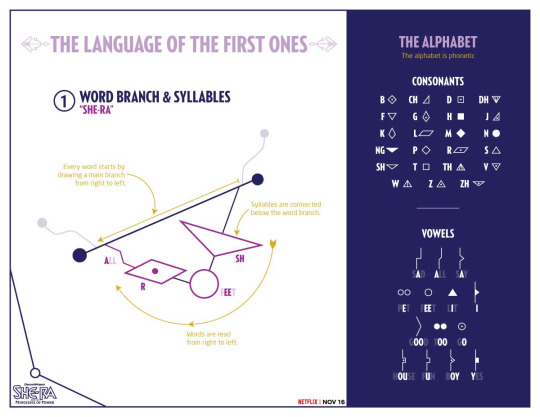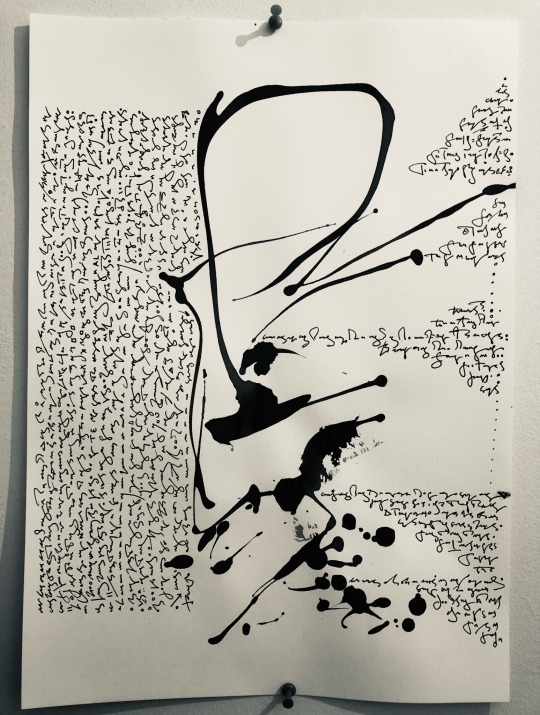I'm Olivia (@worminthedirt) and I've worked on a ton of languages in the past but trying to focus on just one this quarantine
Don't wanna be here? Send us removal request.
Text
Sometimes I like to think about the kinds of sci-fantasy cultures that would grow up on worlds with binary stars or trinary stars, where most of the time you’d have two or more shadows. What sort of beliefs would that create? Shadows are often thought to be related to the soul; if the culture believed in a spirit, would it be dualistic? Two souls inhabiting one body, or two parts to a whole? Maybe they’re both watcher spirits, leading you to fruit or folly. When the suns eclipse each other, you’d only see one shadow; what then?
What about on tidally-locked planets where the only habitable space is in the terminator of the shadow–a narrow world of perpetual twilight, bordered by desert and icecaps. If there are no compasses, how are directions determined? What names do they get? Something to do with ice and fire? How are those two ideas treated?
How about on the tidally-locked habitable moons of gas giants? Where one side of the planet will never see the gas giant, and the other will always have it in view? What myths could be created about the gas giant and the sun? Other moons? Rings? What sort of holidays or ceremonies could be planned around the passing shadow of the planetary ring?
What about the rare moons that aren’t tidally locked? How do you determine the calendar? What myths rise with the eclipsing of the sun by the gas giant, glowing like fire with the sun behind it? Would there be different kinds of days and nights? More than just two? Long nights spent in the shadow of the gas giant?
What myths would a culture create on a habitable rogue planet, with no stars for light, perhaps heated by tidal forces between it and a moon.
How about an undersea culture forever bound under the kilometers-thick ice moon like Europa? With no awareness that anything might even exist above the ice? That is where the universe ends: somewhere in the ice.
Some fun food for thought for you fellow worldbuilders.
3K notes
·
View notes
Text
long time no see
so im gonna show yall how words are written in Blokkan
originally it was just going to be written letter by letter like many real world languages. but i was looking through some comments on my previous posts and someone suggested words be written similarly in a kanji-like format, where a standalone symbol translates to a word. i was wondering how this could be done and i think ive come up with a system!
this system is based off the crafting table. a word is a 3x3 block of letters that flow in a certain direction in order to be read. let me show you what i mean.

in this box there are 9 spaces for 9 letters, mirroring the 9 spaces available in the crafting table. the first 3 letters are placed top left to top right, the 4th is placed under the 3rd, the 5th next to the 4th, and so on in a snake-like pattern. if youre having trouble visualizing what it looks like, this is the order:

so now that we have the direction the letters should be read, im gonna provide an example. take the Blokkan word for creeper (krīpr, its unchanged since creepers are uniquely named and iconic). here’s the Blokkan letters which make up the word:

see the dot next to the third letter? that signifies a double letter, so in this case it’s pronounced as a long /i/ sound. now lets put all these letters into the grid, and itll look like this:

remove the large gaps between the letters and youve made a Blokkan word! there should be a space between letters that are adjacent to each other whereas there isnt for letters on top of each other.

therell probably be some more tweaking to this system and adding some finetuning but that is roughly the system that words will be taking from now on! ill need to find a way to write words that are longer than 9 letters but I’ll figure it out. let me know what you think and if you have any suggestions!
145 notes
·
View notes
Photo

The syllable “SA,” in the Siddham script, used as a focus for meditation in Shingon Buddhism. https://www.instagram.com/p/CCufowfnXit/?igshid=1a9323jxh1ou5
1 note
·
View note
Photo

As we get closer to International Mother Language Day, here’s my carving of “mother tongue” in the Adlam script. More at endangeredAlphabets.net/alphabets/adlam. https://www.instagram.com/p/B8Eo2HvgDvJ/?igshid=laxrgp6ole43
9 notes
·
View notes
Text

Asemic pwoermd sculpture
6 notes
·
View notes
Photo


Concept sketch vs. final painting.
“I am from another dimension”
LR, 2019
143 notes
·
View notes
Photo



The Susipokhi script, one of many writing systems Trent Pehrson has devised for his Idrani language.
61 notes
·
View notes
Text
Announcing the first edition of VATUM
Great news for conlangers everywhere!
We are announcing the first edition of VATUM, a quarterly collection of original conlang literature! Readers can either access the document as a PDF for free or choose to purchase a physical copy. Both these options are available at: https://www.desduwij.com/vatum
A huge thanks to the very first contributors: Chris Brown, James Hopkins, Anthony Harris, Jeffrey Brown, and Franc Kravos; and special thanks to editor Jackson Bradley!
52 notes
·
View notes
Photo

For the past year my biggest conlang endeavor has been working out the writing system for Yuktepat, and I think I’m close to the “end.” The aesthetics are settled, the infrastructure’s in place. I don’t have glyphs for all or even most of the words in Yuktepat, but the inventory of phonetic and semantic bits and pieces is large enough that it’s easy to combine them to make up new glyphs on the fly. The next order of business is working on a phonetic script to complement it. This script would be used alongside Tepatic glyphs by some of the surrounding languages of Tiptum. The individual letters are mostly derived from simplified Tepatic glyphs. In other words, they are to Tepatic glyphs what hiragana is to Chinese characters, so I’m calling them “Tiptum hiragana” until I can make a proper name. The last couple of days I’ve been “doodling” in it, like in the image above. The “words” are nonsense, I just wanted to see how the letters look connected, but so far I’m pleased with some of the possibilities.
31 notes
·
View notes
Text
tell me a pretty thing.
112K notes
·
View notes
Text

siyar su shun
ro teyosin yar fos reyam make
era kira reyam o kira reyamsare
som nafurmi kumo
ro kira som pishe
22nd of June
i am going to start writing in Teyosin
it is raining and it was raining before
it was very sunny
i like the rain a lot
i’m going to try to write something in my conlang every day if i can now cause it was pretty helpful today. i needed to make a few new words and it made me solidify some grammar bits. also, i now have over 100 words :•)))
0 notes
Text

this has been in development on and off for a few months now, but i finally have a writing system i’m pretty satisfied with!! this is a first for me, since i’ve never been able to make something that looks decent.
these are just the basic blocks of my abugida like system, since there are also parts added to them to represent consonants at the end of the syllables.
0 notes
Text
Writing In Eternian
Hey! I made a post about a little season 5 easter egg yesterday (not linking it here because for some reason it blocks the post from showing in the tags)and while I was poking through the tags, I noticed that a lot of people want to learn how to use First Ones writing! Writing and orthography are actually things I’m really interested in, so I decided to make this guide for people. It’s a bit more in-depth than the official press release, so if you just want to use that, feel free!

Here’s the original tweet from the She-Ra Twitter account, which has more examples: twitter. com /dreamworksshera/status/1055474341553623040
Here we go! Putting it under a break so it doesn’t eat up your whole screen.
Keep reading
231 notes
·
View notes



